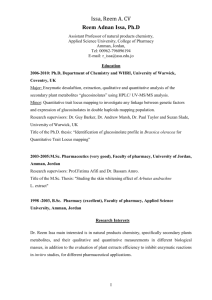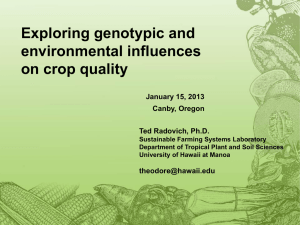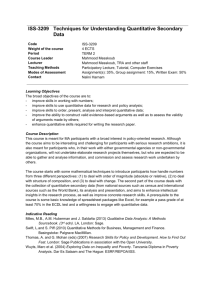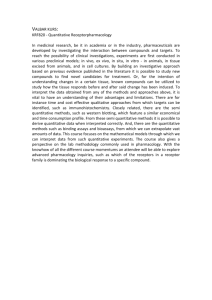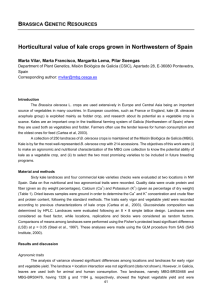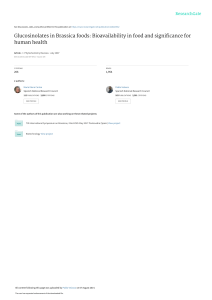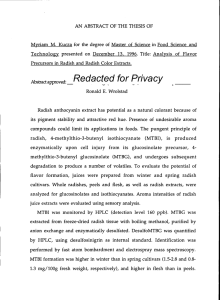المعلومات المطلوبة من الكليات:
advertisement
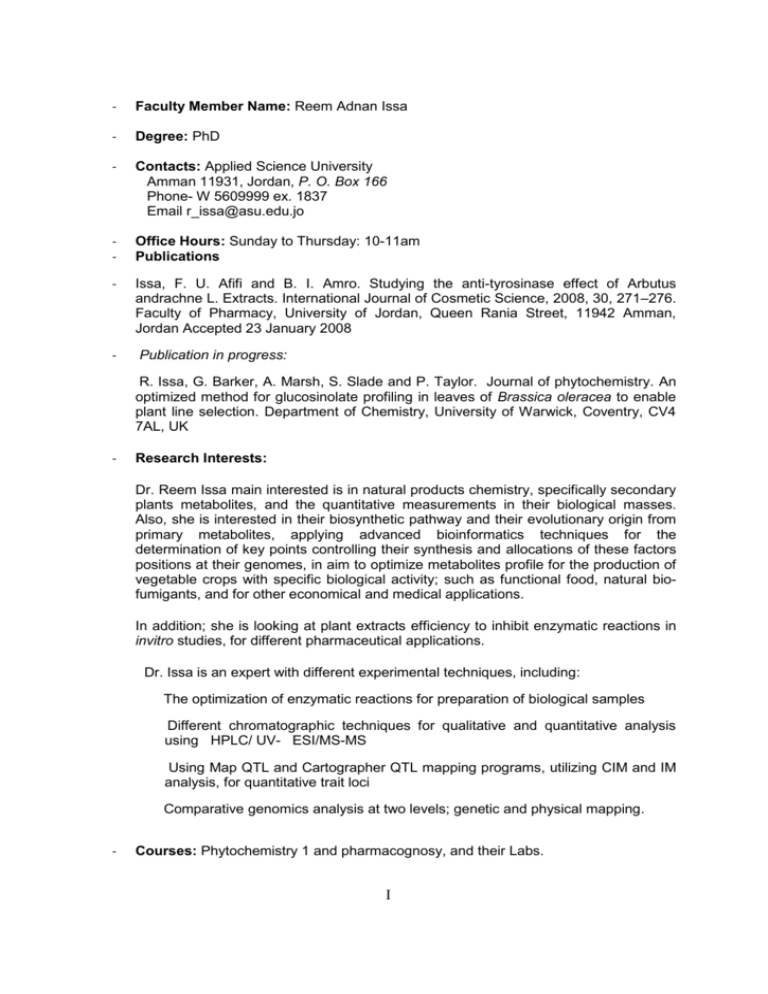
- Faculty Member Name: Reem Adnan Issa - Degree: PhD - Contacts: Applied Science University Amman 11931, Jordan, P. O. Box 166 Phone- W 5609999 ex. 1837 Email r_issa@asu.edu.jo - Office Hours: Sunday to Thursday: 10-11am Publications - Issa, F. U. Afifi and B. I. Amro. Studying the anti-tyrosinase effect of Arbutus andrachne L. Extracts. International Journal of Cosmetic Science, 2008, 30, 271–276. Faculty of Pharmacy, University of Jordan, Queen Rania Street, 11942 Amman, Jordan Accepted 23 January 2008 - Publication in progress: R. Issa, G. Barker, A. Marsh, S. Slade and P. Taylor. Journal of phytochemistry. An optimized method for glucosinolate profiling in leaves of Brassica oleracea to enable plant line selection. Department of Chemistry, University of Warwick, Coventry, CV4 7AL, UK - Research Interests: Dr. Reem Issa main interested is in natural products chemistry, specifically secondary plants metabolites, and the quantitative measurements in their biological masses. Also, she is interested in their biosynthetic pathway and their evolutionary origin from primary metabolites, applying advanced bioinformatics techniques for the determination of key points controlling their synthesis and allocations of these factors positions at their genomes, in aim to optimize metabolites profile for the production of vegetable crops with specific biological activity; such as functional food, natural biofumigants, and for other economical and medical applications. In addition; she is looking at plant extracts efficiency to inhibit enzymatic reactions in invitro studies, for different pharmaceutical applications. Dr. Issa is an expert with different experimental techniques, including: The optimization of enzymatic reactions for preparation of biological samples Different chromatographic techniques for qualitative and quantitative analysis using HPLC/ UV- ESI/MS-MS Using Map QTL and Cartographer QTL mapping programs, utilizing CIM and IM analysis, for quantitative trait loci Comparative genomics analysis at two levels; genetic and physical mapping. - Courses: Phytochemistry 1 and pharmacognosy, and their Labs. I Scientific training at the University of Warwick, UK, 2006-2009 • Structural application of spectroscopy • Structure elucidation by means of NMR and MS • Advanced multi-nuclear NMR spectroscopy • Chromatography • Genetics, genomics and bioinformatics • Biological chemistry Training Seminars and conferences attended - Studying the Skin whitening effect of Arbutus andrachne L. Extract, the 3rd international conference of the Royal medical services and the Royal College of physicians of London, Amman, Jordan, 2006 Department team building and developing course, University of Warwick, UK, 2006 CAP Training (introduction to teaching in higher education for postgraduate), University of Warwick, UK, 2007 Supporting engineering and physical sciences students: A workshop for demonstrators, University of Manchester, UK, 2007 Extraction, qualitative and quantitative identification of desulfated glucosinolate content in Brassica leave extracts, the 2nd glucosinolate conference, taking the field into the next decade, Denmark, 2009 The annual postgraduate’s symposium in chemistry at the Department of Chemistry, University of Warwick, UK, 2007-2009 The annual postgraduate’s symposium at Warwick HRI, University of Warwick, UK, 2007-2009 Identifying novel Quantitative Trait Locus affecting glucosinolates biosynthesis in Brassica oleracea, the 11th Eurasia conference on chemical sciences, the Dead Sea, Jordan, 2010 Workshop of writing papers and proposals, during the11th Eurasia conference on chemical sciences, the Dead Sea, Jordan, 2010 3rd international conference on drug discovery and therapy. February, 2011, Dubai, UAE Master Abstract This study was carried out to assess the possible anti-tyrosinase activity of Arbutus andrachne L. extract, and to evaluate the obtained results in accordance with the inhibitor standards, using dopachroma method described by Morisaki and Ozaki (1996), with some modifications. Three different inhibitor standards were selected for the present study, namely: Arbutin, Hydroquinone and Kojic acid. A. andrachne stems were extracted using five different solvents: chloroform, butanol, ethanol, methanol and water. The concentration required by each inhibitor to inhibit 50% of the enzyme activity (IC 50) II was measured for the standard and for each plant extract. The obtained results showed that methanolic extract is the most potent one, with lowest IC50 value, compared to other extracts. The important secondary metabolites of A. andrachne, namely arbutin and hydroquinone as well as other constituent such as -sitosterol and ursolic acid were identified by TLC and hydroquinone was isolated by preparative TLC. For the formulation of a cream with whitening effect, the methanolic plant extract was selected and two different oil in water emulsions were formulated, one is anionic emulsion, the other is non-ionic emulsion. The obtained results of accelerated stability study showed that the anionic emulsion is more suitable to be used in the formulation of skin whitening cream containing this extract. - PhD Abstract Glucosinolates are a group of secondary plant metabolites, which have been shown to play important roles in human health and nutrition. Identification of novel genes or regulators of expression are important for optimising the glucosinolate composition of Brassica crops. This project aimed to develop a HPLC based methodology for quantifying these compounds within Brassica leaf material and to use this to map Quantitative Trait Loci for individual glucosinolates within Brassica oleracea mapping populations. Glucosinolates were analysed using an optimized HPLC-UV method developed in this study for complete separation of desulfated glucosinolates with high resolution for quantification measurements. The reproducibility of the desulfation reaction was improved for robust enzymatic reaction of sulfatase. A data dependent MS and MS/MS methodology was developed to confidently identify seven glucosinolates in the 89 AGDH plant lines distributed between aliphatic and indolic glucosinolate, with different combinations from the parental plants A12DHd and GDDH33. For the quantitative measurements of glucosinolates, an optimized level of glucotropaeolin was used as an internal standard (IS1). In addition, we have demonstrated the first use of a second internal standard (IS2) to significantly improve the reproducibility of the quantitative measurements. Aliphatic glucosinolates were predominant over indolic glucosinolates, where progoitrin has the highest abundance. This methodology was then used to identify Quantitative Trait Loci for individual glucosinolates and for key points in their biosynthesis. A major gene effect was found near the top of B. oleracea LG9 associated with aliphatic glucosinolate synthesis. In addition other Quantitative Trait Loci were identified which corresponded with previous work by other groups and to which individual gene function could be attributed. A number of novel Quantitative Trait Loci were also found which control the synthesis of glucosinolates distributed on the nine chromosomes of C genome. A combination of the quantitative data and genetic analysis of glucosinolate profiles was used to infer the existence of factors at distinct loci and associated these with specific steps in the biosynthesis pathway of glucosinolates in B. oleracea. The assignment of genes or gene regulator functions to Quantitative Trait Loci identified in this study was consistent with known positions of Brassica candidate genes and collinear regions of the Arabidopsis genome. Consequently, this information can be applied to other Brassica species for breeding vegetable crops with modified glucosinolate profiles. III 4
